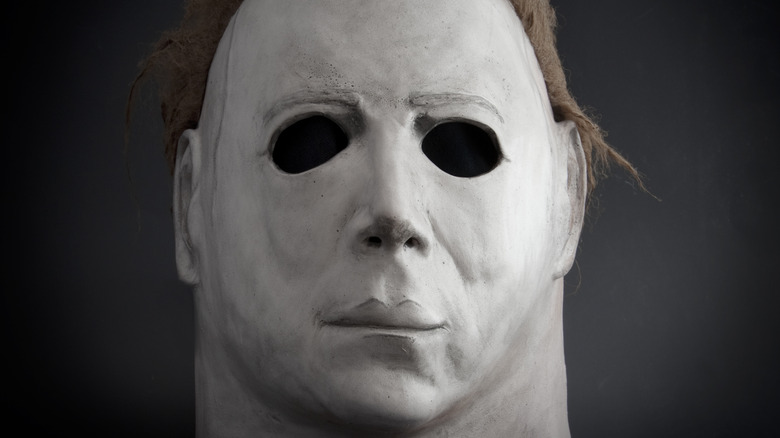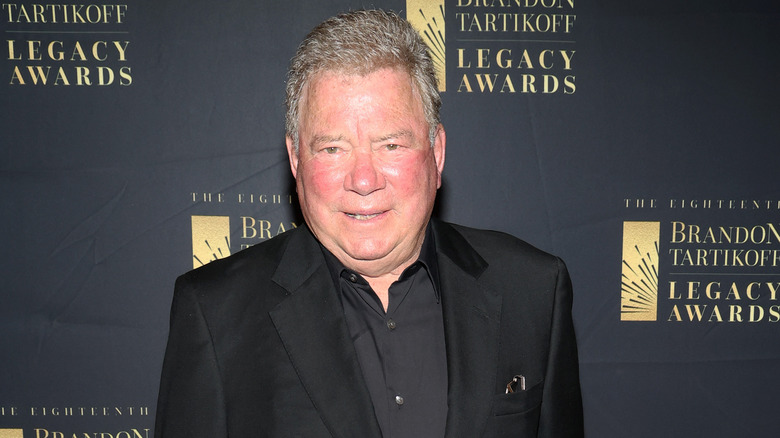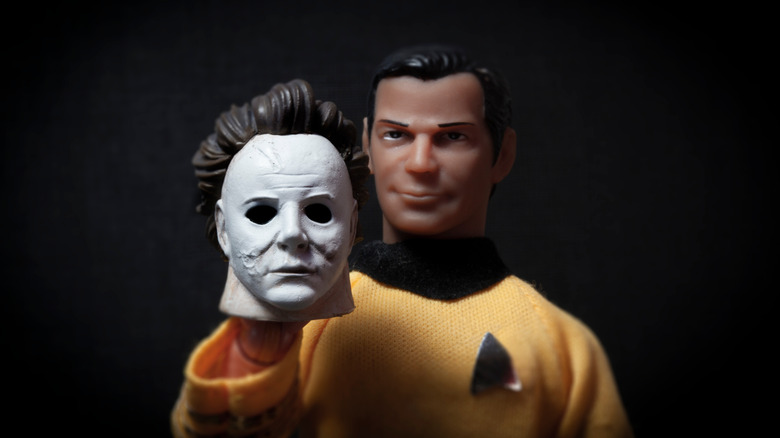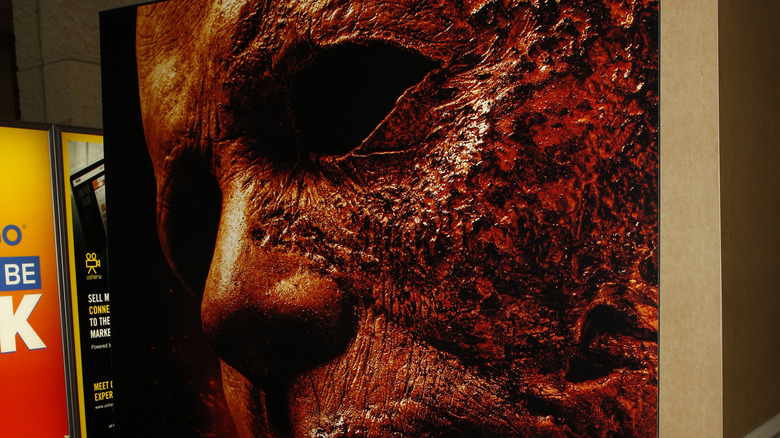The Unnerving Connection William Shatner Has To Michael Myers
The ultimate countenance of horror was born on Halloween night in 1963 when six-year-old Michael Myers seized a kitchen knife and stabbed his sister to death with it, as the story goes. Movie lovers will never forget the first time they watched "Halloween" (1978) and saw the boy in a clown costume with that iconic white mask on, standing before police in his front yard in a grotesque state of deranged composure after committing that atrocious crime. Years later, he'd recommence his saga of malicious bloodshed, all the while sporting that lifeless mask that has since become a legendary motif of the horror genre.
Of course, that's all movie jargon. Obviously, Michael Myers never existed, and his crimes were thankfully restricted to the darker realm of cinematic storytelling. Still, the image of that legendary mask has haunted people's sleeping and waking moments alike for generations, but you might not know that the chilling Myers mask is actually based upon the face of a well-known actor whose reputation is anything but threatening. According to The Hollywood Reporter, Michael Myers was killing people while sporting the face of "Star Trek's" William Shatner.
The Michael Myers mask was inspired by William Shatner
Really, it's almost laughable to think that the most iconic face in horror belongs to William Shatner. For a time, rumors that the mask was a sort of reimagining of Shatner's face had been floating around, but they weren't actually substantiated until Rick Sternbach, illustrator/designer of the Star Trek franchise, was brought on board the set of "Halloween II" in 1981. According to Star Trek, Sternbach and one of his associates were trying to dig up a series of Myers masks to use during filming, but they could only exhume one.
He took a closer look at the inscription located on the inside of the mask where the serial number/manufacturing information could be found, and he was shocked to discover that the origins of it could be traced back to his work on "Star Trek." "I noticed that there was some wording molded into the neck area. There was a model number, and 'Don Post Studios.' I made a call, read off the model number, and the word came back 'It's our Captain Kirk mask,'" Sternbach recalled years later. Apparently, the Myers mask was based on one of Capt. Kirk's "death masks" that appeared in the popular sci-fi series back in the day. Of course, it looked a little different than the one we're used to seeing wrapped around Michael Myers' head, being that it was meant to mimic an actual face (per Star Trek).
What William Shatner thought of the mask
When William Shatner found out that it was his own lifeless face dealing grisly death on the streets of Haddonfield, Illinois, he was as shocked as anyone. However, it wasn't fear that overtook him. "I thought, 'Is that a joke? Are they kidding?'" Shatner said on a YouTube interview with Jake Hamilton. Apparently, he recognized it immediately, so it didn't take any sort of extensive digging into serial numbers or toy manufacturers on his part to realize that it was his face appearing in the "Halloween" movies. "They made a mask of my face on 'Star Trek' out of clay so I would not have to be available for the prosthetics they would have to put on my face to look old or evil or whatever it was they were making me look like. So somewhere along the line, someone got that mask and made a mask of it for [the holiday] Halloween."
Originally, the mask had been intended for actual trick-or-treaters before the idea for "Halloween" ever came about. It was only incidental that the lifeless aura of its stark white face and bottomless black eyes fit perfectly into the mold of what would become perhaps the most successful and revered horror phenomenon of all time (via The Hollywood Reporter).
How the mask came to be in Halloween
It boiled down to a moment of mere chance that, in hindsight, looks more like serendipity than anything else. The New York Post reports that "Halloween" production designer/editor Tommy Lee Wallace was on the avid hunt for the perfect serial killer mask for John Carpenter's vision when he found what would become the film series' poster face. While scanning the shelves of a magic shop in Los Angeles, his eye caught one particular mask amongst the others.
"Up on the shelves were these full face masks of Richard Nixon, and down at the end was Mr. Spock. And right next to it was this blank face Capt. Kirk," Wallace told Netflix in 2019. He ended up leaving the shop with the Shatner mask along with an unnerving Emmett Kelly clown mask, but after enough consideration, he and the "Halloween" crew agreed unanimously that the former was the superior option. After a few renditions to the mask (wider eyeholes, darkened hair, removed eyebrows/sideburns, and a fresh coat of white paint over the original natural skin tone), the face of Michael Myers was born (per The Hollywood Reporter). To date, there have been 12 different installments in the "Halloween" franchise, the most recent of which being "Halloween Kills" (2021), directed by David Gordon Green, according to Good Housekeeping. The revamped slew of films from Green is set to conclude this year with "Halloween Ends," which currently has a release date of October 14.



